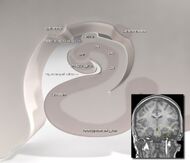No edit summary |
No edit summary |
||
| Line 1: | Line 1: | ||
{{BioPsy}} |
{{BioPsy}} |
||
| + | {{Infobox Anatomy | |
||
| + | Name = {{PAGENAME}} | |
||
| + | Latin = gyrus parahippocampalis | |
||
| + | GraySubject = | |
||
| + | GrayPage = | |
||
| + | Image = Gray727.svg | |
||
| ⚫ | |||
| + | Image2 = Hippocampus (brain).jpg | |
||
| + | Caption2 = Parahippocampal gyrus labeled at bottom center. | |
||
| + | System = | |
||
| + | Precursor = | |
||
| + | MeshName = Parahippocampal+Gyrus | |
||
| + | MeshNumber = A08.186.211.577.710 | |
||
| + | DorlandsPre = g_13 | |
||
| + | DorlandsSuf = 14816442 | |
||
| + | }} |
||
| ⚫ | |||
| + | |||
| ⚫ | |||
| + | The [[parahippocampal place area]] (PPA) is a subregion of the parahippocampal gyrus that plays an important role in [[memory]] and [[recognition]] of scenes (rather than faces or objects). It first appeared in amphibians as a section of the [[paleopallium]]. [[Amphibians]] were the first [[vertebrates]] to colonize land, thus a need for terrestial navigation and memory of scenes. |
||
| ⚫ | The '''parahippocampal gyrus''' (or '''hippocampal gyrus''') is a [[grey matter]] [[cerebral cortex|cortical]] region of the [[brain]] that surrounds the [[hippocampus]]. This region plays an important role in the formation and retrieval of [[topographic | topographical]] [[memory]]. |
||
| + | |||
| + | This area of the brain, like the cigulate gyrus, also seems to serve some function in modifying the expression of emotions. |
||
==External links== |
==External links== |
||
* {{BrainInfo|hier|146}} |
* {{BrainInfo|hier|146}} |
||
| + | |||
| − | {{Limbic system}} |
||
| + | ---- |
||
| + | |||
| + | |||
| + | |||
{{Prosencephalon}} |
{{Prosencephalon}} |
||
| Line 13: | Line 36: | ||
[[Category:Cerebrum]] |
[[Category:Cerebrum]] |
||
[[Category:Neuroanatomy]] |
[[Category:Neuroanatomy]] |
||
| − | [[Category:Limbic system]] |
||
{{enWP|Parahippocampal gyrus}} |
{{enWP|Parahippocampal gyrus}} |
||
Revision as of 18:17, 4 December 2006
Assessment |
Biopsychology |
Comparative |
Cognitive |
Developmental |
Language |
Individual differences |
Personality |
Philosophy |
Social |
Methods |
Statistics |
Clinical |
Educational |
Industrial |
Professional items |
World psychology |
Biological: Behavioural genetics · Evolutionary psychology · Neuroanatomy · Neurochemistry · Neuroendocrinology · Neuroscience · Psychoneuroimmunology · Physiological Psychology · Psychopharmacology (Index, Outline)
| Parahippocampal gyrus | ||
|---|---|---|
| Medial surface of left cerebral hemisphere. ("Hippocampal gyrus" visible near bottom.) | ||
| Latin | gyrus parahippocampalis | |
| Gray's | subject # | |
| System | ||
| MeSH | A08.186.211.577.710 | |
| Parahippocampal gyrus labeled at bottom center. | ||
The parahippocampal gyrus (or hippocampal gyrus) is a grey matter cortical region of the brain that surrounds the hippocampus. This region plays an important role in the formation and retrieval of topographical memory.
The parahippocampal place area (PPA) is a subregion of the parahippocampal gyrus that plays an important role in memory and recognition of scenes (rather than faces or objects). It first appeared in amphibians as a section of the paleopallium. Amphibians were the first vertebrates to colonize land, thus a need for terrestial navigation and memory of scenes.
This area of the brain, like the cigulate gyrus, also seems to serve some function in modifying the expression of emotions.
External links
| This page uses Creative Commons Licensed content from Wikipedia (view authors). |

